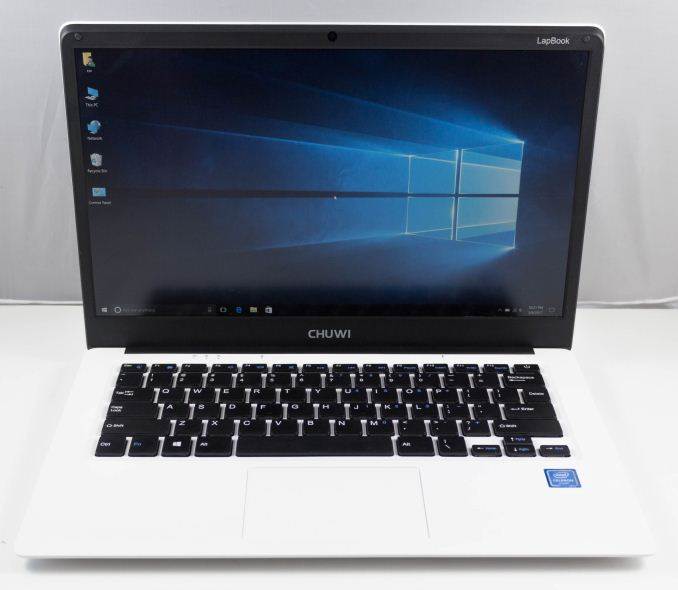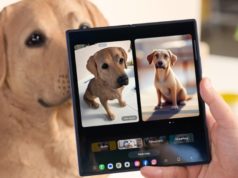In this industry, it is all too easy to focus only on the high end of the PC market. Manufacturers want to show off their best side, and often provide samples of high-end, high-expense devices more than their other offerings. While these devices are certainly exciting, and can set the bar for how products should perform, there is definitely a gap compared to being able to review the other end of the market. A couple of years ago, HP launched the HP Stream 11, which at the time was a solid entry into a new price bracket, but it was, of course, a device with a lot more compromise than HP’s more expensive offerings. But, HP was not sampling the Stream 11 to very many people, as can be the case on devices like this, so I went ahead and purchased the Stream 11 for review.
When Chinese manufacturer Chuwi reached out with an opportunity to take a look at the Chuwi LapBook 14.1, it was a great chance to see how this market has evolved over the last several years, and to see how another manufacturer tackles the inescapable compromise of this end of the market. The Chuwi LapBook 14.1 offers a lot of computer for the money. The price has varied a bit over the last six weeks, but it has been as low as $249.99 USD, and is currently for sale for $264.99.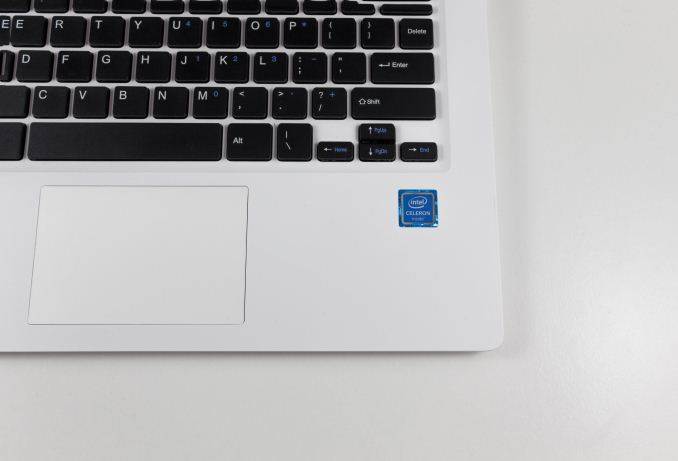
As its name would suggest, the Chuwi LapBook 14.1 is a 14.1-inch laptop, featuring an Intel Celeron N3450 CPU, which is the latest 14 nm Atom cores, codenamed Goldmont, and in this case, it’s a quad-core model which can hit 2.2 GHz in its 6-Watt TDP. We’ll dig into Goldmont more in a bit, but Goldmont in this configuration is known as Apollo Lake, and it features Intel HD Graphics 500 with 12 EUs up to 700 MHz. The LapBook also features 4 GB of RAM, and 64 GB of eMMC storage, as well as a MicroSD slot for expansion up to another 128 GB of storage.
Where the Chuwi LapBook stands out though is in the display. The LapBook features a 1920×1080 IPS panel, when most laptops in this price range feature 1366×768 TN displays. Most, but not all, with HP offering a Carrizo-L powered 14-inch notebook with IPS as well, so while Chuwi is not alone in this market, the IPS display is a huge step up over the TN competition. The LapBook also features 8 mm bezels, which is quite a bit thinner than most laptops, and especially laptops at the $250-$300 price range.
| Chuwi LapBook 14.1 | |
| CPU | Intel Celeron N3450 4C/4T 1.1-2.2 GHz 2MB L2 Cache 6W TDP |
| GPU | Intel HD Graphics 500 12 Execution Units (Gen 9) 200-700 MHz |
| Memory | 4 GB Dual-Channel |
| Display | 14.1″ 1920×1080 IPS 60 Hz |
| Storage | 64 GB eMMC Expandable up to +128GB microSD |
| I/O | 1 x USB 3.0 Port 1 x USB 2.0 Port 1 x micro HDMI micro SD Card Slot 1 x Headset Jack |
| Dimensions | 330 x 227 x 9-20 mm 13 x 8.93 x 0.35-0.79 inches |
| Weight | 1.5 kg / 3.3 lbs |
| Battery | 45 Wh, 24W AC Adapter |
| Wireless | Intel Dual Band Wireless-AC 3165 1×1 with Bluetooth 4.2 |
| Price | $250-270 USD |
Chuwi has also gone with an 802.11ac wireless card from Intel, which is good to see. It’s a single channel only, but assuming you have an 802.11ac router, it will offer a lot more performance than an 802.11n model.
Overall, the Chuwi LapBook packs quite a bit in for just over $250, with 64 GB of storage, 4 GB of RAM, a FHD IPS display, and all in a 9-20mm thick package weighing in at a few pounds. It’s very portable, it has decent specifications, and the price is good, but specifications don’t make a computer, so let’s dig into it a bit more to see how it stacks up.
One area where Chuwi has done very well, especially for this price point, is the design of the LapBook 14.1. The entire laptop is unsurprisingly made from plastic, but the plastic has a nice textured feel to it, making it very easy to hold, and it never feels like it’s going to slip out of your hands. The white color is a nice change from the traditionally black or gray PC market as well.
Since this is an Atom core, the laptop doesn’t need a fan, which of course makes the device silent, and, at least on the review sample, there isn’t any coil whine perking up over the lack of fan noise. The bottom features four nice large rubber feet, making the laptop stay planted on a desk or table, and while it may seem silly to mention this, there are still laptops that don’t get this right.
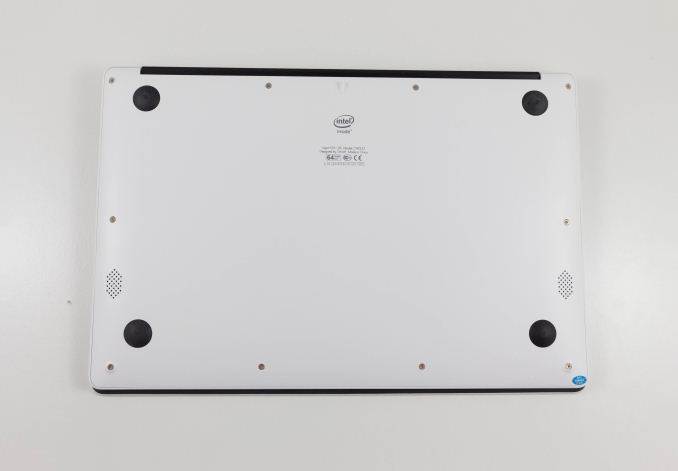
Opening the laptop up, the thin bezels on the display really stand out, and allow the LapBook 14.1 to feel smaller than most 14-inch notebooks. The thin design, starting at 9 mm at the front and tapering to 20 mm at the back, make it very easy to stick in a bag and carry with you. It’s not the lightest design around, but the overall construction is solid enough that there isn’t any creaking when holding the laptop on a corner. Considering the price, the construction is solid.

The keyboard is also surprisingly good. It’s nice to see a black keyboard on this laptop, since it gives great contrast to the white system, and makes the keys easier to see. Hopefully no one is shocked that this laptop does not offer any sort of keyboard backlighting, which is unfortunate, but to hit these kinds of price points, it has to be expected. Key travel is also quite good, and the keyboard feels quite solid, with a much better key feel than I would have expected at this price, and at this thin of a laptop. Chuwi hasn’t stuck with a normal keyboard layout though, and they’ve made the same mistake as some other manufacturers in placing the power button as one of the keys. Having the power button where Delete should be is never a good idea, and can easily cause you to shut off the computer when trying to edit something. It also starts a chain reaction on key placement, because Delete must be somewhere, and in this case, it is above the enter key, forcing the key beside the space bar. Although you could likely get used to this, if you ever switch between machines, having keys in odd locations is likely going to cause you frustration, and it would be best if Chuwi would move power off the keyboard.
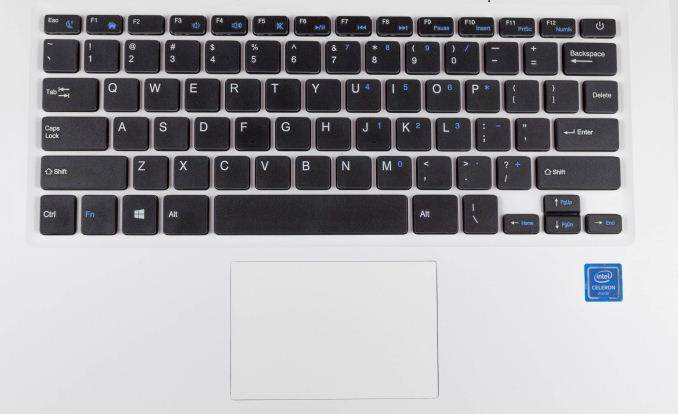
The trackpad is another story though. It’s not a very good trackpad, and the customization for it is very limited with the included drivers. The default scroll direction is reversed from normal, with no way to change it, and you can’t disable the trackpad with a keyboard shortcut either. For simple operations, it’s acceptable, but if Chuwi wanted to focus its energy somewhere to make the experience better, this would be an easy place to start. The notebook would be better used with a mouse, if possible.

There’s not a lot of expansion, with just a single USB-A 2.0 port on the right, and a single USB-A 3.0 port on the left, along with mini HDMI and micro SD, and a headset jack. The power is supplied via a barrel connector, which doesn’t look very robust. It would have been nice to see USB-C power, although that may not be possible at this price point. My experience with thin barrel connectors is not great though, since they can get bent, or snapped off, and finding a replacement is not always simple since they are not always the same size. It’s also worth mentioning that the USB ports are upside down as well, which is not a huge deal, but it’s a bit weird when trying to plug something in.
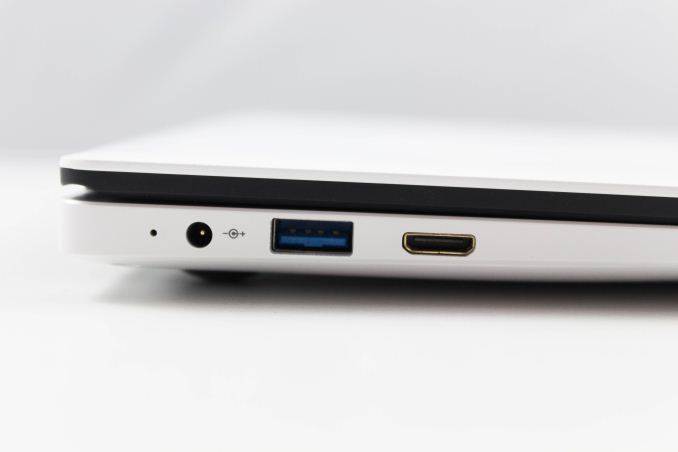
Overall, Chuwi has done a decent job on the LapBook 14.1. The design is solid, with a pleasant look and feel, and while it can’t compete with all-metal notebooks, it’s really not meant to. The plastic feels decent, and the matte texture really helps.
Intel’s Atom processor is their low-cost offering, with a smaller die size than Intel’s Core series, allowing them to sell them for less money, but keep their margins up. Atom has had a bit of a roller coaster of a ride over the last several years. When it launched in 2008, it was an in-order design, offering low power, but also low performance. It was originally on the 5-year cadence that Intel was still doing with their main CPUs as well, which really made the original Atom long in the tooth, despite several process changes along the way.
Eventually Intel saw the threat of ARM processors, and tried to speed up the cadence of Atom so that it could be used in thin and light tablets, as well as smartphones. We saw some brief success with Atom, partially due to a strategy of contra-revenue, and partially because Windows RT was a failure, but with Intel never gaining a foothold in smartphones and basically only available in Windows tablets, Intel made the decision to cancel the Broxton tablet platform completely. This was a bit of a shock, and I’m sure it caught a lot of their partners a bit flat footed, since they had devices being sold with Cherry Trail that would never get an update.
But this didn’t impact the low-end PC market, because Intel was moving forward with their PC platform, which they dubbed Apollo Lake. The new 14 nm successor to Airmont, named Goldmont, was going to live on, albeit in less devices. Much of the confusion about the death of Atom has to do with just how many products it was in.
| Comparison of Intel’s Atom SoC Platforms | |||||||
| Node | Release Year | Smartphone | Tablet | Netbook Notebook |
|||
| Saltwell | 32 nm | 2011 | Medfield Clover Trail+ |
Clover Trail | Cedar Trail | ||
| Silvermont | 22 nm | 2013 | Merrifield Moorefield |
Bay Trail-T | Bay Trail-M/D | ||
| Airmont | 14 nm | 2015 | ‘Riverton’ | Cherry Trail-T | Braswell | ||
| Goldmont | 14 nm | 2016 | Broxton (cancelled) |
Willow Trail (cancelled) |
Apollo Lake | ||
So, the low-end PC market was still going to go ahead, with Intel focusing on its strengths, despite the decrease in the PC market, rather than push a new Atom against the latest ARM products in tablets and phones. While this retrenching by Intel likely seemed like a good idea for…
